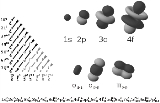
Atomic orbital
Overview
Electron
The electron is a subatomic particle with a negative elementary electric charge. It has no known components or substructure; in other words, it is generally thought to be an elementary particle. An electron has a mass that is approximately 1/1836 that of the proton...
or a pair of electrons in an atom
Atom
The atom is a basic unit of matter that consists of a dense central nucleus surrounded by a cloud of negatively charged electrons. The atomic nucleus contains a mix of positively charged protons and electrically neutral neutrons...
. This function can be used to calculate the probability of finding any electron of an atom in any specific region around the atom's nucleus
Atomic nucleus
The nucleus is the very dense region consisting of protons and neutrons at the center of an atom. It was discovered in 1911, as a result of Ernest Rutherford's interpretation of the famous 1909 Rutherford experiment performed by Hans Geiger and Ernest Marsden, under the direction of Rutherford. The...
. The term may also refer to the physical region where the electron can be calculated to be, as defined by the particular mathematical form of the orbital.
Atomic orbitals are mathematical functions that depend on the coordinates of only one electron.

